A few days after traveling north to Chantilly, I was southbound to Fontainebleau, another Tom Simpson design that is ranked 4th in France by top100golfcourses.com. By this point in the trip, I’d become quite familiar with how to navigate around L’Ile De France by metro and train, an effective system, all things said. However, the trek to the club, from my hotel in the 10eme Arrondissement, was still arduous, as I battled the morning commute, golf bag slung over my shoulder, feet raw and calves sore from sauntering all around town the previous four days, head pounding and stomach acidic from the {redacted} bottles of wine and pints of beer I’d consumed the night prior while watching Manchester City take on Real Madrid at a packed bar on the left bank of the Seine. Two train rides and a ten-minute Uber later, I arrived to a sunny yet quiet morning on the grounds of the hundred and fourteen year old golf club.
“Far more than Chantilly, Fontainebleau seems to be a consummate reflection of the personality of its creator, his disposition having been distilled, with full vigor, into his creation here.”
As I’ve said before, I don’t believe that any golf course, or any art-form for that matter, is evaluated within a vacuum; by nature, we are pre-dispositioned to compare and contrast: between works within an artist’s catalog, between our own previous experiences, between often arbitrarily selected groupings. In this case, it was obvious that I’d judge the Simpson courses against each other. And Fontainebleau undoubtedly suffered from this, looking back.
Although Fontainebleau is undoubtedly a more exhilarating and flamboyant golf course than Chantilly, especially from tee-to-green, for reasons I can’t quite totally and adequately put into words yet — and may never be able to — it didn’t grip me as forcefully as my first exposure to Simpson’s work. And since, it has not lingered as persuasively and pervasively in my thoughts. Such a phenomenon isn’t exclusive to golf architecture, of course. The Counterlife, for example, is a more innovative, a more gripping, a better written, and a better crafted book than The Human Stain; yet the latter is probably my favorite of Philip Roth’s novels, whereas I have never felt like re-reading the former. The musicianship and production of AM are superior to that of Whatever People Say I Am, That’s What I’m Not, but, once again, I prefer and re-listen to the latter album far more often than the former.
My initial impression told me that Fontainebleau is a glitzier and flashier club than Chantilly. Whereas Chantilly’s clubhouse is replete with wood-paneled walls on which historic black-and-white pictures and club plaques are hung, unflamboyant brown-leather upholstered furniture, and a simple bar with merely one beer-tap, Fontainebleau’s clubhouse, conversely, features red-velvet couches set over swanky multi-colored carpets, luxurious Louis XIV-style gilded bronze furniture, elaborate oil-paintings of golfers and the club’s important figures, and a fully stocked – and I mean fully stocked – bar.

In fact, the Commune of Fontainebleau is primarily known for the stunning Chateau de Fontainebleau, which served as a residence for the French monarchs from Louis VII to Napoleon III. Surrounded by vast Italian gardens, punctuated by countless marble statues jutting from pools the length and width of football fields, and fronted by a gold-capped wrought-iron fence, an element of this monarchal opulence seems to have seeped over to the golf club. Now a Unesco World Heritage site, I passed by the chateau on my way back to the train-station and it is, undoubtedly, a breathtaking compound. In short, despite being one of Europe’s most exclusive and distinguished golf clubs, I never felt uncomfortable or unwelcomed at Chantilly – in fact, totally the opposite – , whereas at Fontainebleau, I felt as if I was walking on egg-shells, that I had to avoid prolonged eye-contact with any members, that they tolerated my presence around the clubhouse only as lengthily as it took for me to pay, mainline a life-reaffirming espresso, and walk to the first tee.
Perhaps this is merely the impression I received from a single visit, which, admittedly, is far too small of a sample size off which to base such a bold claim, but Fontainebleau seemed to be treated more as a casual retreat, an occasional sanctuary from the hustle and bustle of real life, than as an integral part of its members’ daily-existences, a second-home as Chantilly undoubtedly is by its membership. I might be wrong, but first impressions are, as everyone knows, hard to shake. Moreover, in the Trophee Gounouilhou, France’s annual nationwide inter-club event, Chantilly has emerged victorious a joint-record seventeen times in total, whereas Fontainebleau is winless.
Despite this, the golf course, itself, is wonderful and, as importantly, unique. It’s truly unlike anything else I’ve played (though, I admit that I am woefully under-traveled in Europe). Far more than Chantilly, Fontainebleau seems to be a consummate reflection of the personality of its creator, his disposition having been distilled, with full vigor, into his creation here. A Cambridge trained lawyer, Tom Simpson was known and cherished as a loving eccentric, who, according to author Alfonso Erhardt, collected walking sticks, Persian rugs, Georgian Furniture, and cigars, among other luxuries. Moreover, he routinely arrived at his projects in chauffeured silver Rolls-Royces and kept a book detailing all of the wines he sampled. Unlike most of his compatriots, then and since, Simpson’s personal wealth allowed him to practice golf architecture essentially as an avocation. As a result, the freedom, the pleasure, and the ardor that are most often discernable when one practices something out of pleasure and nobility, rather than for economic gain or out of necessity, are evident in his work, especially at Fontainebleau. Fontainebleau is a playful golf course, a fun house.
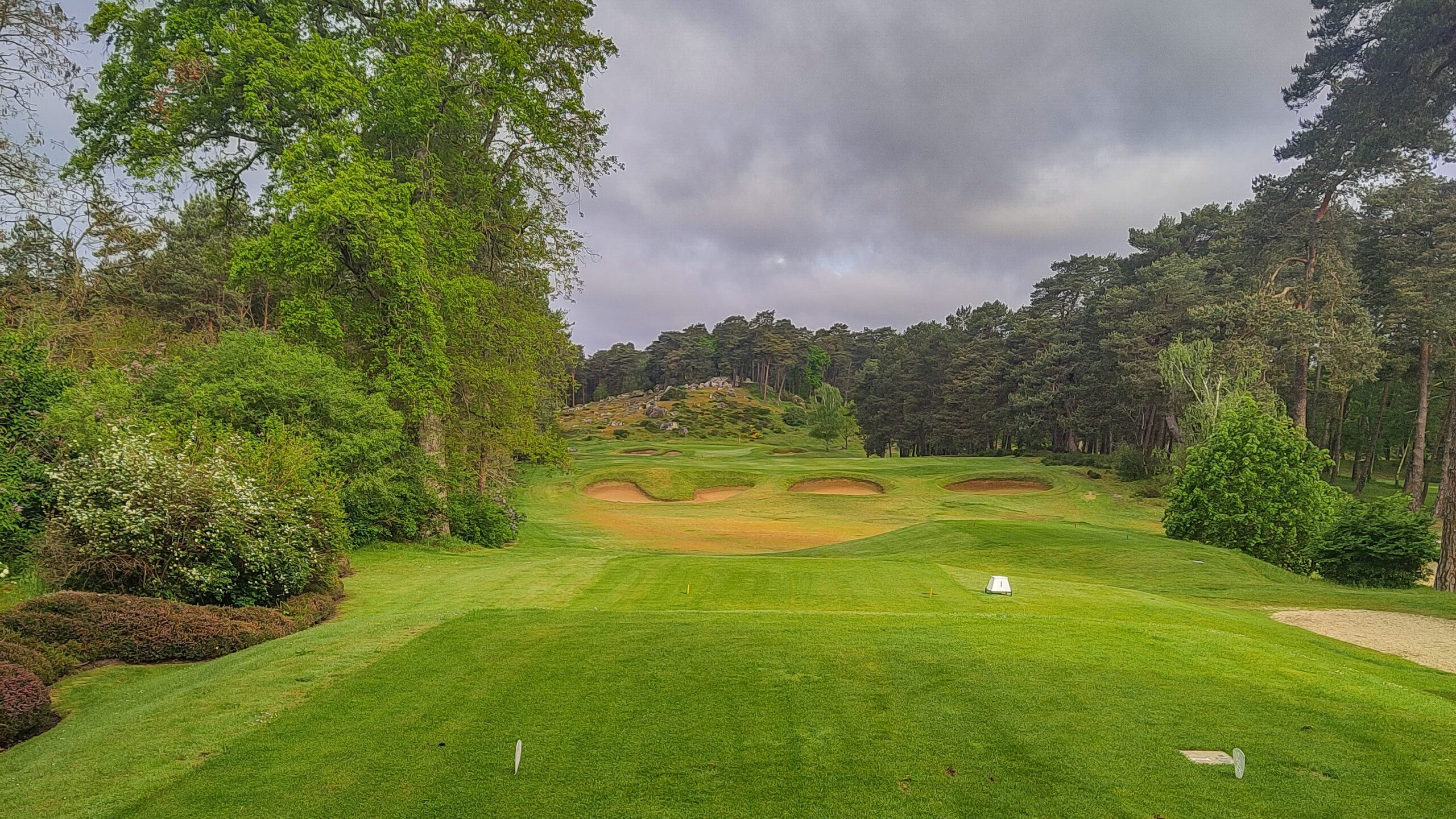
The wonderful 1st, a microcosm of the golf course
As at Chantilly, the first hole at Fontainebleau simply makes you want to play the seventeen that follow. Set at the base of the clubhouse, directly under the main window looking out from the dining room, you immediately get a good sense of what is to come: cross bunkering, rolling fairways, elegant green sites, and tremendously undulating putting surfaces. It’s all here, in its full glory and majesty, on the opening hole. \
- The approach to the 1st
- The undulating, rolling green at the 1st
Fontainebleau features some of the more elegant and clever green sites I’ve seen, and the 1st is among the better of the set. Simpson routed the golf course around a central hill, the high point of the property which acts as a sort of gathering point, with a number of holes playing into it, then the next off of it.
- The par 3, 2nd
- Closer look at the green on the 2nd
The 2nd, a longish par 3, is another hole which uses visual deception to throw the golfer off balance. From the tee, the right side of the surface is obscured by the rocky and gorse-covered bank, while all that is visible of the left is the sharp false front. In truth, though, the gently front-to-back slopping surface beyond the false-front is quite generous, though a high and solidly struck tee-ball is required to hold it.
The golfer is greeted by one of the more spectacular vistas on the course once he makes the uphill trek from the 2nd green to the 3rd tee, which is set at the very summit of the hill. If I have one overriding complaint about Fontainebleau it is that there are a few too many of these quite tight, dead-straight tee shots that must find such tree-enveloped fairways, or else. If one is having an off-day with the driver around these parts, then the sideways-punch-out will be routinely called upon. All in all, some further, albeit selective, tree-removal would undoubtedly improve the golf course.

The par 5, 3rd
With a good tee-ball, or unless you’re Cameron Champ-long, the central bunker shouldn’t come into play; regardless the humpy fairway is apt to yield awkward lies that can easily bring tops or thins into play if one selects a three-wood second in order to get home in two strokes. Once again, Simpson’s architecture plays with the golfer’s mind brilliantly here. The green site, which sits blind from short of the central bunker, is elegant and tightly guarded, with a surface bisected by a pair of tiers.
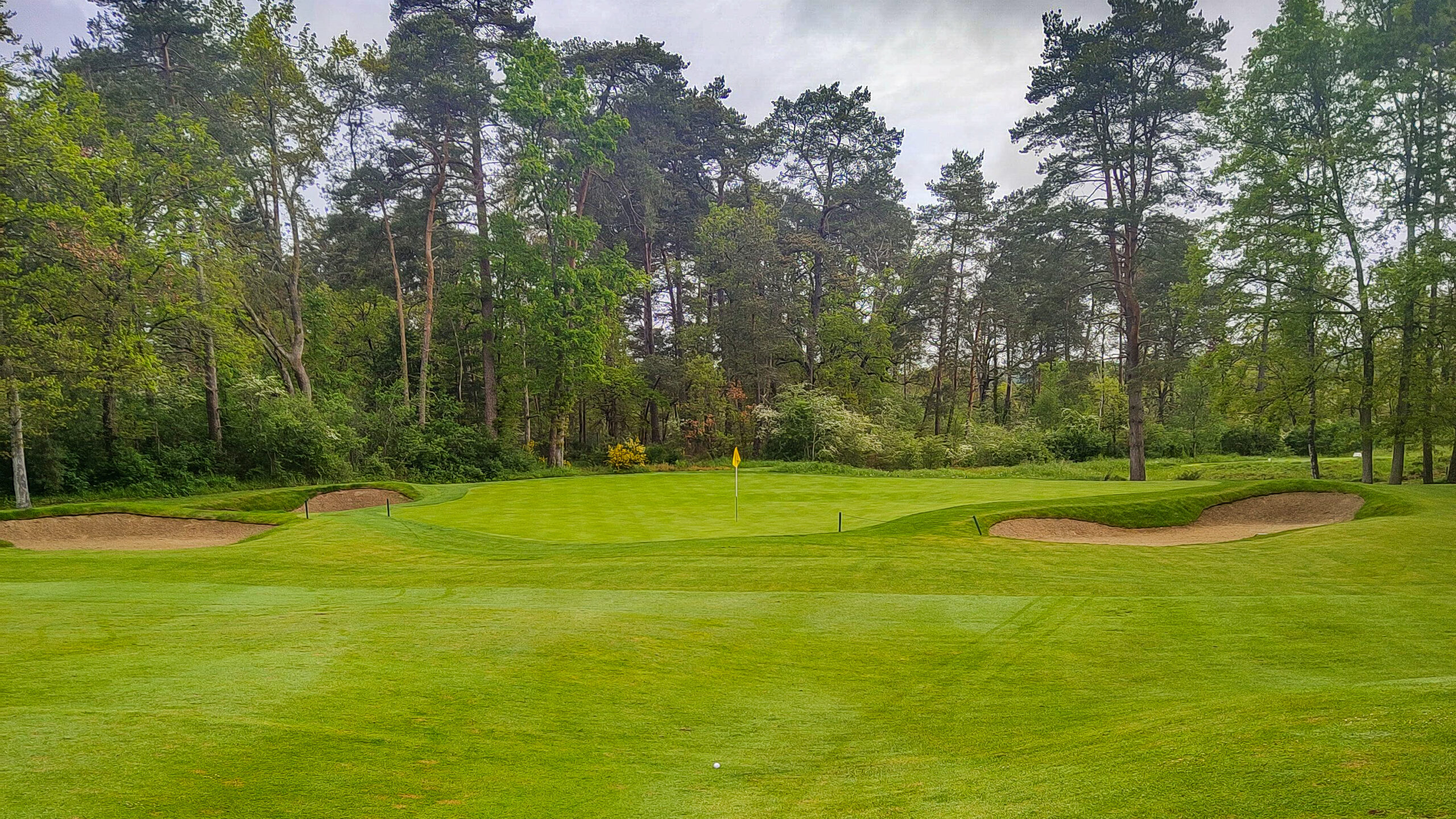
The attractive green at the 4th
The diagonal-running 4th requires the golfer to carefully select his line from the tee in order to leave himself not too long of an approach into another well-surrounded green, which falls off abruptly at the back. The stretch from the 4th to the 8th is pretty meat-and-potatoes golf, throughout which one’s games will be tested with a series of difficult tee shots followed by mid to long irons approaches. It’s a really solid, albeit slightly sloggy, stretch of golf.

The 6th from in front of the forward tees. Notice the sunken green
The 6th is the best of these holes, a shorter par 4 featuring some attractive cross-bunkering and a sunken, punchbowl-ish surface that sits obscured to the fairway. If I was to pin-point a hole that best represents Simpson’s strengths and ethos as an architect at Fontainebleau, it might be this one. Running across a nondescript tract of the property, he added some unusual elements, combined with slight visual deception in order to add interest where the ground didn’t provide it, itself. Here, it’s easy to imagine that so many lesser, less-bold architects would have simply flanked the fairway with bunkers and then pushed up the green, thus creating a perfectly fine, if commonly-seen, golf hole. Yet Simpson did something rather opposite, taking a risk which paid off.

The 9th, with the resplendent clubhouse looming
The 9th, which, unlike Chantilly, returns to the clubhouse, features another elegant green-site, surrounded by a handful of bunkers and cut within a natural amphitheater behind which the putting green, patio, and clubhouse are set. On a midsummer’s day, with the trees and flowers in bloom, I cannot imagine that there are many better inland settings than this for the royal and ancient game.

The tee shot on the all-world 12th
More stock-solid golf follows the turn, until the arrival of the genuinely world-class par 5, 12th; after this, Fontainebleau really shifts into gear. Cross bunkers, threatening boulders, an insanely contoured and false-fronted putting-surface, and a charming backdrop to the green-site all combine to make this gently climbing par 5 one of the best and most memorable in golf.
The longer hitter can reach in two swings, but any miss wide will leave an incredibly difficult pitch whose line onto the severely back-to-front canted green must be intelligently judged. Once again, plotting, steeple-chase golf would probably yield the best result over time, but, hey, that’s no fun when you’re on vacation. So I gave it a crack, missed left, and was thus severely punished with a pitch that, even after a dozen tries, I couldn’t get within thirty feet of the hole.
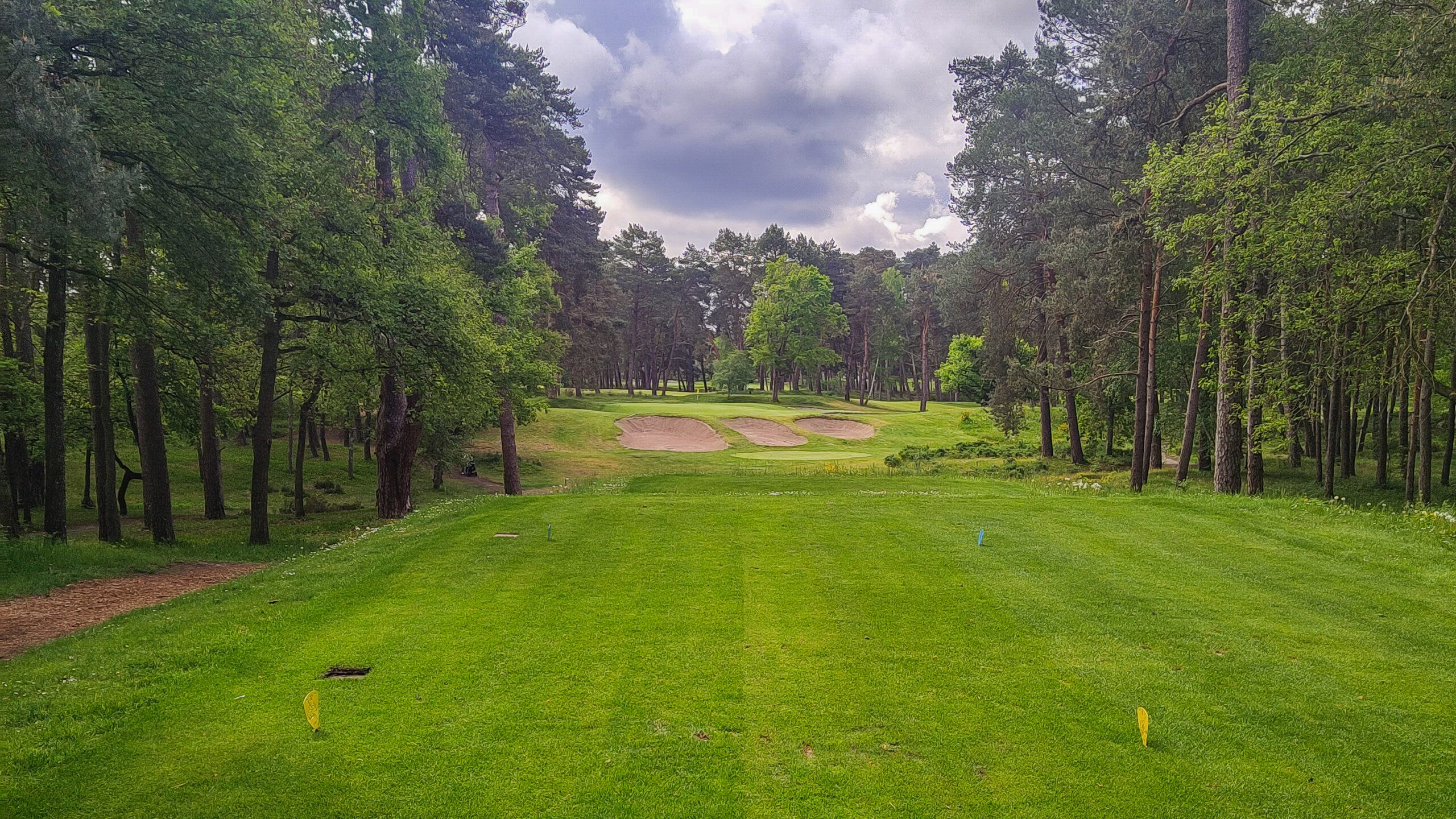
The difficult par 3, 14th
The 14th is likely the most pictured hole at Fontainebleau, and with good reason. Another precise long iron is called for here to cap off a set of one-shotters that is undoubtedly among the more challenging few I’ve played. Anyone who plays them at even par, or better, is gaining at least a stroke, if not more, on the field.
- The 15th tee shot
- The view from the fairway, with the green set beyond and below the cross-bunkers
A precise tee ball is required on the long and right-to-left sweeping par 4, 15th. The approach is the most riveting on the golf course, as your second must fly the cross bunkers, yet land short enough of the surface in order not to be propelled over it by the fronting slope, which originates from said bunkers. Similar to the 7th at Chantilly, on this hole Simpson transferred the purest essence of links golf from his home-land to the forest of L’Ile de France.

After the driveable 17th playing into the base of the central hill, a relatively simple hole I nevertheless made a meal of as a wicked sun-shower descended upon the golf course, the final tee ball, set high above the previous green, calls for one last good swing. A fairway finder should yield an approach played with a wedge and thus a good chance to cap off the day with a birdie that makes the wonderful meal afterwards taste even better. Overcompensating for the quack-hook I hit off of the 17th tee, I crop-dusted one way right here, into the first fairway, then missed a relatively make-able birdie, which, in all fairness, only somewhat lessened the enjoyment of my post-round boeuf bourguignon, an age-old staple that I took on the lovely patio overlooking the 9th green.


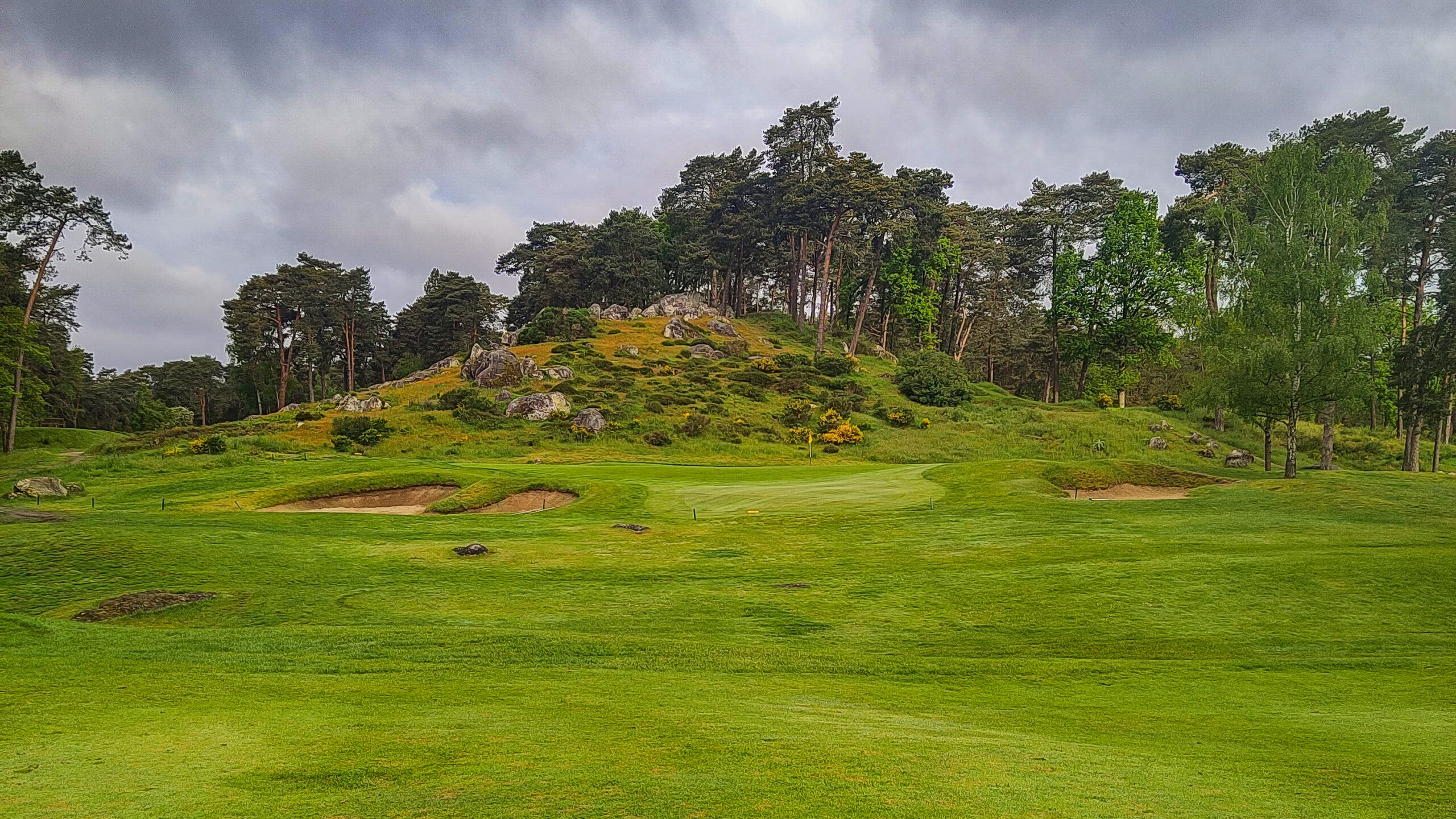




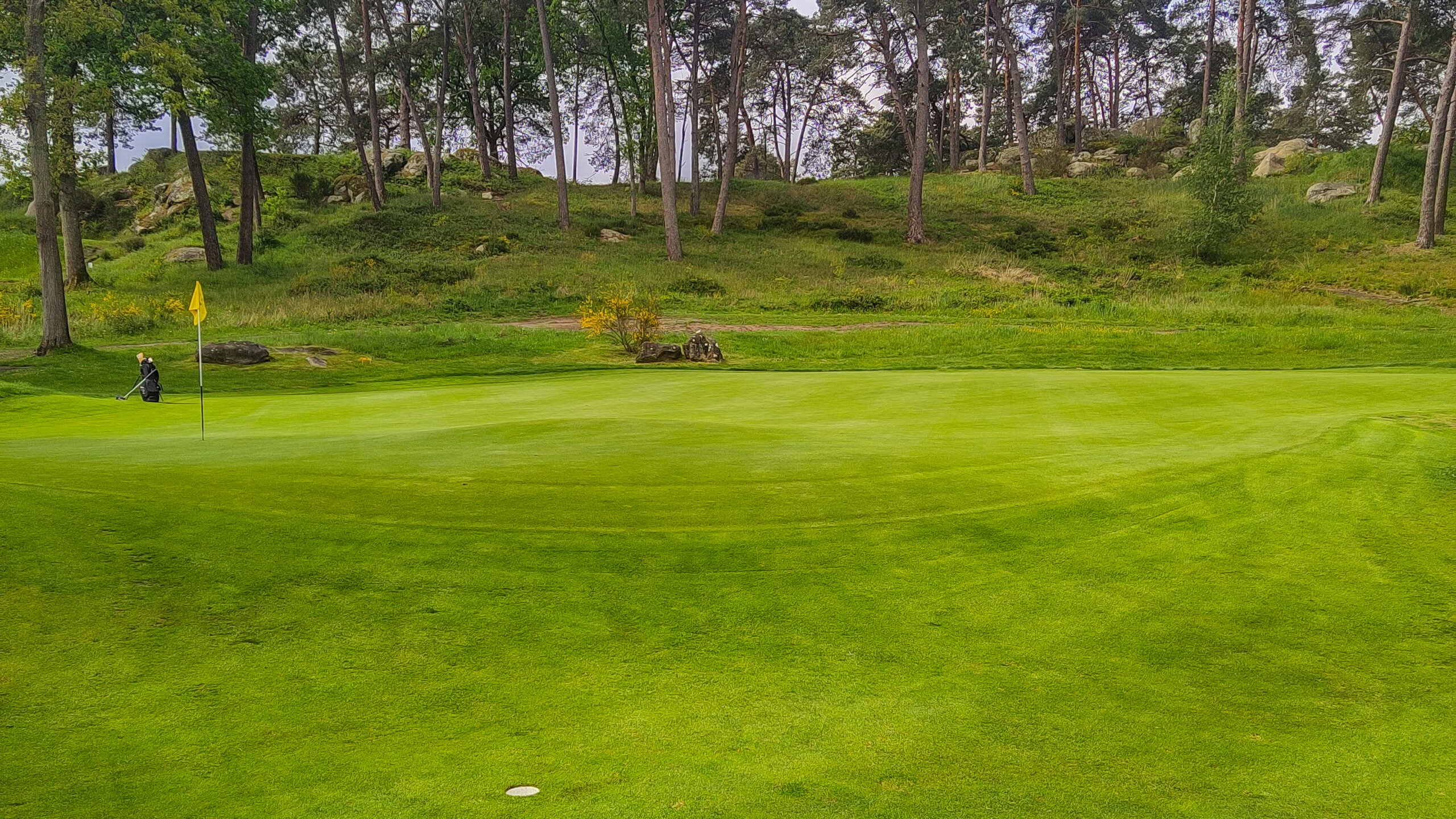









Leave A Comment